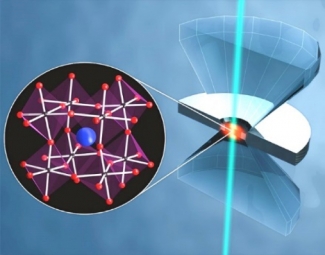Nanostructured materials (quantum dots, nanowires, nanocrystals) have led to a large research field in the last two decades. While there is a huge body of work on their synthesis, the molecular-level details of their interactions with their chemical environment is only beginning to be explored. High pressure experiments offer access to tackle such questions.
At relatively low pressures (a few hundred MPa), only intermolecular distances are varied by application of pressure. This is much less perturbative than variation of temperature or chemical composition. The behavior of nanocrystals at these low pressures yields information on the properties of the interface between thenanocrystals and their chemical environment, including their protective ligands. Higher pressures (GPa range) can result in phase changes in the solvent or in the nanocrystals themselves. The former will again lead to a change in the interaction of the nanocrystal with its environment. The latter affords access to new materials with new optical and electronic properties.
We use photoluminescence spectroscopy and Raman microspectroscopy to study these phenomena, employing a diamond anvil cell and a hydraulic cell to subject samples to high pressure. Learn about some of our work here and here.
This work is supported by the NSF through the JILA Physics Frontier Center. ![]()



 The Physics Frontiers Centers (PFC) program supports university-based centers and institutes where the collective efforts of a larger group of individuals can enable transformational advances in the most promising research areas. The program is designed to foster major breakthroughs at the intellectual frontiers of physics by providing needed resources such as combinations of talents, skills, disciplines, and/or specialized infrastructure, not usually available to individual investigators or small groups, in an environment in which the collective efforts of the larger group can be shown to be seminal to promoting significant progress in the science and the education of students. PFCs also include creative, substantive activities aimed at enhancing education, broadening participation of traditionally underrepresented groups, and outreach to the scientific community and general public.
The Physics Frontiers Centers (PFC) program supports university-based centers and institutes where the collective efforts of a larger group of individuals can enable transformational advances in the most promising research areas. The program is designed to foster major breakthroughs at the intellectual frontiers of physics by providing needed resources such as combinations of talents, skills, disciplines, and/or specialized infrastructure, not usually available to individual investigators or small groups, in an environment in which the collective efforts of the larger group can be shown to be seminal to promoting significant progress in the science and the education of students. PFCs also include creative, substantive activities aimed at enhancing education, broadening participation of traditionally underrepresented groups, and outreach to the scientific community and general public.